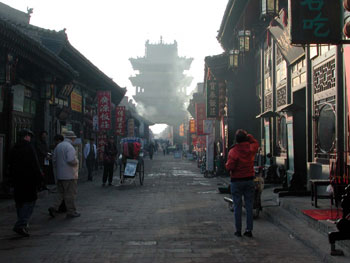Hong Kong iMail, January 1, 1999
A Fortress Besieged
By PAUL MOONEY in Pingyao
China's old walled city of Pingyao is so well-preserved, say locals, that if a ghost of the Ming dynasty (1368-1644) were to return to wander the streets today, she would have little trouble negotiating her way around the maze of tiny alleyways that has changed little since the 1300s.
The wall runs six kilometers around the old fortress city and is the most intact remaining city wall of the 2,000 that once dotted the Chinese empire. Founded 2,700 years ago as a military base, Pingyao was rebuilt in 1370, and much of its architecture today remains typical of that time. Behind the high walls and tiled eaves lining the narrow streets lie timeless family compounds built around leafy central courtyards that are hidden from the road by double wooden gates.
"We have given the world a textbook, a living museum," Zhao Changben, a retired culture worker, who grew up in Pingyao, says proudly. "And this is of significance for all mankind."
But if you want to catch a glimpse of China's past here, you better hurry. The old city's pages are fading fast, the sad result of official neglect and misdirected zealousness.
 Like other historically significant sites around China, Pingyao is struggling to balance progress and preservation and battling ignorance, the lack of enforcement of regulations and the debilitating legacy under five decades of communist rule.
Like other historically significant sites around China, Pingyao is struggling to balance progress and preservation and battling ignorance, the lack of enforcement of regulations and the debilitating legacy under five decades of communist rule.
Located about 450 kilometers southwest of Beijing in Shanxi province, Pingyao was added to the list of World Heritage sites by the United Nations Educational, Social and Cultural Organization in 1997. "The ancient city of Pingyao is an outstanding example of a Han Chinese city of the Ming and Qing dynasties that has retained all its features to an exceptional degree, and in doing so provides a remarkable picture of cultural, social, economic, and religious development during one of the most seminal periods of Chinese history."
Head down any side street and you'll find one of the remaining grand family compounds that have obviously seen better days. Here and there is a decaying house, the outer walls crumbling into piles of bricks. Elsewhere there are elegant homes, their one-sided roofs slanting elegantly toward their courtyards, a style unique to Pingyao.
"Water is very scarce in Shanxi, and so is a form of wealth here," explains a tricycle driver. "You don't want any of the rainwater to spill into your neighbor's yard."
Despite crumbling walls and aging frames, families still live here, their TVs and electric lights some of the few concessions to modernity. At the gate of the badly damaged Hou Family House, one can still see the stone steps for mounting and tying horses, a sign that the Hou family was once quite prosperous.
To protect the city, the government has implemented a series of regulations, prohibiting the building of new structures exceeding two stories, and requiring that renovations along certain streets strictly follow the traditional structure.
Unfortunately, much has already been lost. Zealous Red Guards damaged or tore down some structures during the Cultural Revolution (1966-1976), when anything labeled feudal was destroyed. Many of the old residences that remain here today--many 150 years or older--are clearly in need of urgent repair. Some 400 have been listed for protection by the government.
A Pingyao archaeologist says 30% of the houses here can be saved if action is taken fast. But he is concerned that funds are lacking, especially for the repair of individual homes. He says that if nothing is done, many of the structures that have stood here for as long as 800 years could soon be reduced to piles of wood and bricks.
"We must fix the scars of history," he says. " Those historical relics that have been damaged by history and those most representative of the culture of Pingyao should be protected first."
Local officials may unknowingly be contributing to the destruction.
"Pingyao officials have not done a good job of dealing with tourism and historical relics," says the archaeologist, adding that local leaders "blindly promote tourism at the expense of history."
He explains that local officials are not well-educated and that they are "too anxious to earn money." "If things continue in this direction, even more of these historical relics will be destroyed," he says.
"Impossible, impossible," cries Lei Jingming, vice director of the Pingyao Planning Committee, who flatly rejects arguments. "These valuable cultural relics were left to us by our ancestors," Lei says. "Only if we properly protect them will there be any value. If you don't do a good job of this who will come?"
Lei argues that the root of the problem is insufficient funding. "The main question is capital," he says. "Where can we get the funds needed to fix all of the old city's many relics?"
"Pingyao has cultural value and traces of history and should be preserved," says a well-known architecture professor in Beijing. "It can be developed and can earn money, but it's a historical site first, and not a tourist site first."
A taste of things to come can be found on Nanda Street, one of four main streets targeted for preservation. Many of the old houses here have been refurbished, and turned into antique shops and restaurants serving the growing number of tourists who make the trek here. Sadly, the new look bears a close resemblance to a Chinese movie set.
"If I can turn a historical site into a movie set, why do I need a Pingyao," asks the Beijing architect, his voice rising with anger. "What do I need with historical sites if I can make a fake one and save money?"